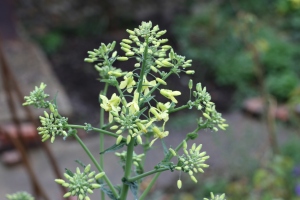Kale, a member of the Brassica family.
A year after the Cavalo Nero was planted out I’m starting to harvest the seeds
From the initial flowers
A mass of flowers and pods
To seed pods forming
To the seed pods – still green and unripe
To the stage where the seeds are starting to dry on the plant
Some seeds ready for picking and drying
A seed pod and it’s seeds
And now it starts all over again
VARIETY: – Nero Di Toscana, orginally from Real Seeds
NOTES and HOW TO –
They will all readily cross with one another so must be isolated. They are biennial, being sown and grown one year to flower and seed the next. Flowers are perfect and cross-pollinating. They are mainly insect pollinated.
Suzanne Ashworth advises growing a minimum of 12 plants to ensure good stronng healthy seeds. Other advice includes roguing out plants that don’t conform to type, but generally plant and grow as you would for eating. Once the winter is over, the plants will start to push out flowers. Flowering starts as the days lengthen quite early in the year. This is the time to start caging, if necessary. I didn’t need to do this as I only grew one variety and there were no other Brassica’s in flower nearby .
Harvesting
Once flowering has finished and the seed pods are developing, any cages can be removed and the pods allowed to mature uncovered. The seed stem often grows much further as the seed pods mature. The pods turn yellow then start turning brown and have a tendency to shatter as they ripen. There is a danger that seed will be lost this way, so keep a constant check on the ripening pods. If you have time, break the seeds
out of the pods into a paper sack every few days as they ripen to maximise seed production.
Otherwise, remove the entire stalk when the majority of the pods have ripened and dried, but not shattered. It is important not to cut the seed stalks too early, while the pods are still green, as the seed will not continue to develop once cut.
Cleaning
Cleaning refers to the removal of chaff and debris, leaving only seed. Cleaned seed keeps better.
Seed should be fully dry for threshing and most of it will shatter from the pods of its own accord. The remainder can be broken out by hand or by beating the pods in the sack and winnowing.
Winnowing is best done outside in a stiff breeze. Pour the seeds steadily from one container to another, allowing the wind to blow the chaff away. Repeat until the chaff is gone and you are left with only seed. Do this over a tarpaulin, in case a sudden gust upsets the container and spills the seed.
Storage
Stored cool and dry, all brassica seed will last for at least five years, giving full germination.
Information from HSL, RealSeeds, Seedy Sunday, Suzanne Ashworth and me







I really hope to save more seeds this year. This is a great post!
There was magnificence in colours that art started to acknowledge and share
with the whole world.